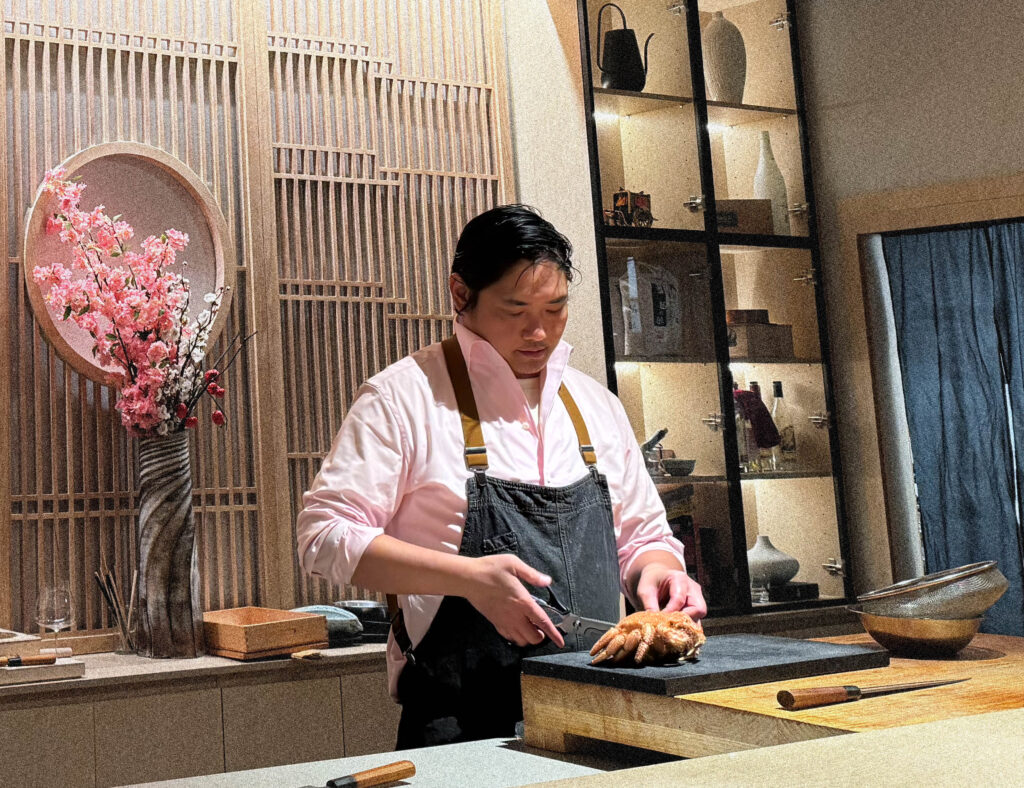With the arrival of October, Otto Phan’s omakase inches closer to what might be considered its conventional peak: the fall and winter months when the genre’s most totemic offerings are at their richest and fattiest. The menu also starts to look a bit more like the one I wrote about back in February—a closing of the loop that, looking beyond the calendar year, effectively marks the start of a new Kyōten “season.”
In short, this is the point in which I really get to judge how Phan’s best bites and flavor combinations hold up over time. Reading between those lines, one may also get a sense of how the chef’s technical aptitude has grown or changed in the interim.
To be clear, Kyōten has been putting out great work for the duration of 2025. Not that every item is always perfect; rather, new creations show continual improvement, the same mistakes are never made twice, and the caliber of each experience is assured by the evergreen quality of certain signature preparations made from octopus, tuna, yellowtail, and eel.
On some level, I think it matters even more that Phan has proven capable of guaranteeing satisfaction even in the so-called “lesser” months, which naturally test his ingenuity even if they grant him access to their own unique treasures from the sea. To draw a comparison: it is said that any winemaker can make a good wine in a good vintage, but that mastery is really shown by the ability to craft a good wine in a bad vintage.
Spring and summer offer those challenging conditions: a chance to serve local produce and cheese and wagyu and to take a firmer hand in smoking or curing or searing particular fish when necessary. All the while, the “Ōtoro,” “Chū-toro,” “Akami,” “Buri,” “Uni,” and “Unagi” never failed. Quite the opposite: they routinely confirmed their place among the finest mouthfuls of food served anywhere—on any night—in Chicago.
Fall and winter almost suffer from the weight of expectations. How will the chef manage to surpass the supreme degree of pleasure he provides during relatively unfavorable circumstances? More pointedly, how can he not hit a grand slam when nature itself seems to be on his side?
Phan himself has characterized 2025’s “cold season” as “one for the record books,” yielding “remarkable” fish (sold for a corresponding premium) that have not been equaled “since 2020.”
Thankfully, what Kyōten charges at this prized moment in time remains consistent: $440 to $490 per person—depending on the day of the week—exclusive of tax but totally inclusive of service (a detail that, with the city’s three-star concepts having now caught up in pricing, almost makes the omakase feel like a surprise bargain).
Comparing what one chef does behind a solitary counter to what Alinea, Smyth, or Oriole do with teams of cooks (to say nothing of managers, sommeliers, captains, or wait staff) at their disposable will never be fair. But this format promises a unique concentration of texture and flavor and interaction that, once it takes hold of you, is hard to ever shake.
Will these last meals of the year be, bite for bite, the restaurant’s greatest? Will they, it then follows, rank as 2025’s most superlative overall? Or will they confirm that hospitality’s most magical memories only strike according to a logic of their own—one that treats convention and expectation as the highest anathemas?
Let us begin.

Tonight, despite it being October, the weather in Chicago remains mild. Thus, the foot traffic in front of 2507 W. Armitage Avenue remains robust, and, with the sun now setting well before Kyōten’s dinner service begins, I am treated to an amusing sight.
I’m not speaking of that usual bit—where patrons, spending hundreds of dollars, encounter a derelict storefront and wonder if this could possibly be the place—or even that associated game of musical chairs (in which parties are escorted over from Next Door or vice versa). No, while it’s true that the restaurant’s front door (papered over, with some scrawls of graffiti for good measure) remains as foreboding as ever, the effect is no inverted.
You see, under cover of darkness, the windows running alongside the dining room (though they’re comprehensively covered with blinds) find themselves crisply backlit by the counter itself. One can make out the slatted wood, the flower centerpiece, and even the motions of a certain aproned chef.
Passersby, in my observation, are invariably spellbound by what they sense is going on inside. Their disappointment, in turn, is palpable (their confusion, at times audible) when the entrance offers no clues. A sensible guess might venture that whatever this is hasn’t opened to the public yet. More than seven years on, that is hardly true. But, indeed, only a rare few pull open those doors and step into Phan’s sanctum.
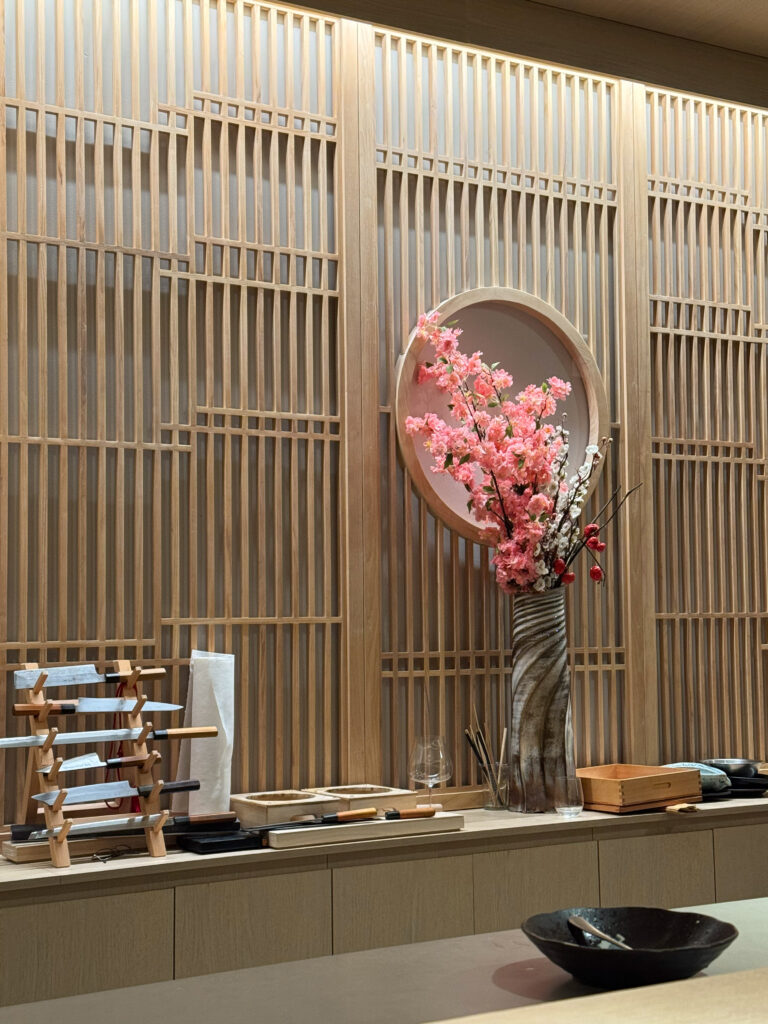
On this occasion, the chef is running behind due to a health inspection earlier that day (“passed with flying colors,” he adds). Thus, the assembled guests are treated to a bit more prep than usual: namely, the cracking of a Hokkaido horsehair crab’s shell and the removal of its meat. This sequence, in which the tiny crustacean’s legs are wringed (using a bottle as a roller) of all flesh, prompts an immediate encounter with the kind of effort that goes into each bite.
But Phan, not missing a beat, makes small talk with the audience—splitting his attention between a pair of returning customers (who want to talk about rare sake) and the groups of newcomers (who ask all the usual questions about where he’s from and how he got started).
The chef coyly (given his pedigree) explains that he worked in great restaurants until he finally decided he wanted to do things “his way” and opened the original trailer (a picture of which remains hung near the door). Speaking of the move from Austin to Chicago, Phan notes that it was originally much harder to source quality fish here compared to what was available in Texas. Such a statement seems crazy on the surface, but it speaks to how long it has taken for the city’s high-end omakase scene to develop (and, really, how far it has to grow even in comparison to what we’d consider minor markets).
Otherwise, the assembled diners get their drink orders settled, and one almost seems sheepish about ordering a beer. Phan assures them that he “wouldn’t put it on the menu if it was a bad decision,” and I respect the fact that those taking the leap on an experience at Kyōten can leave the restaurant—free of pressure or shame—having spent no more than $20 or $30 per person on à la carte beverages. (Corkage, at $40 per bottle, is not that far off either.)
With the continued help of his new assistant (who remains every bit as polite, attentive, and efficient as he was in September), the chef gets the meal under way.
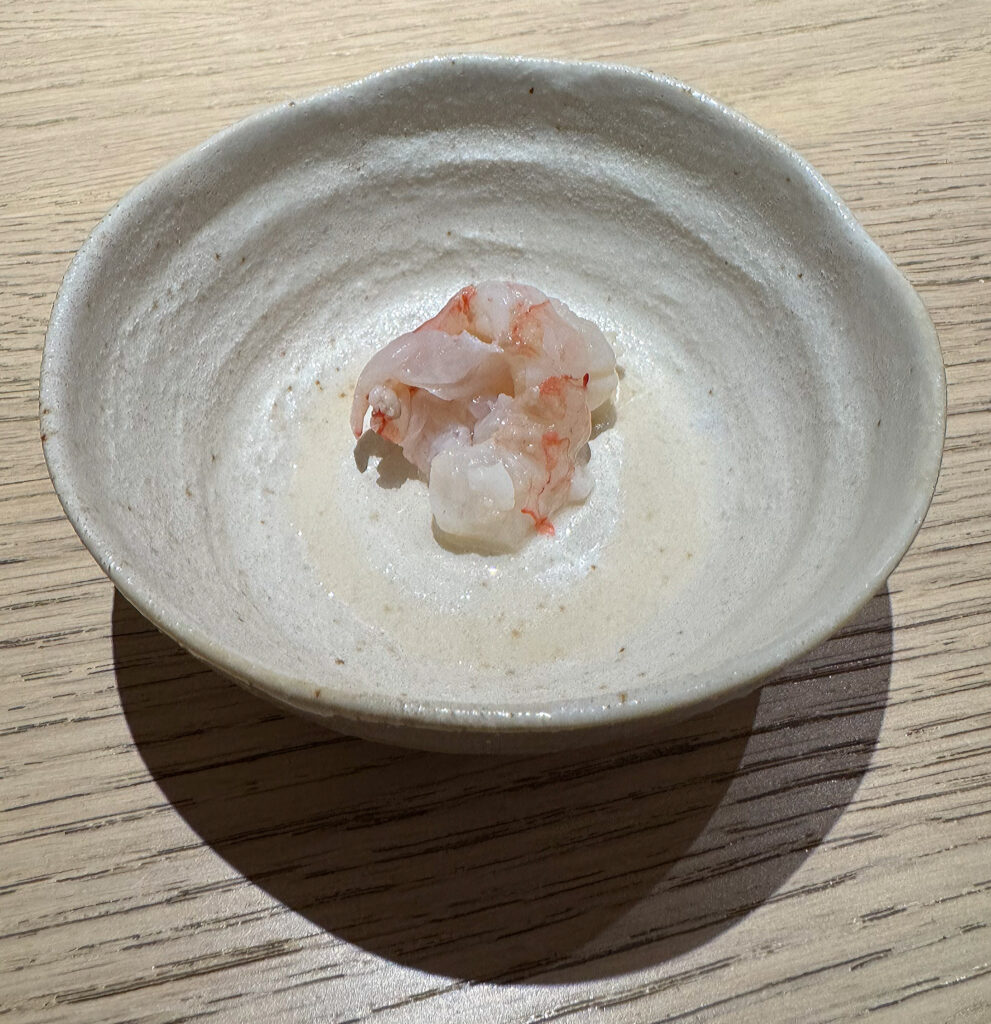
The present menu, for all the fuss about the cold season’s exceptional product, starts on a familiar note: with the “Aka Ebi” (a kind of red prawn sourced from Hawaii) that has consistently appeared since July. Though Phan originally paired this crustacean with local cherry tomatoes, the preparation has found its stride as a kind of “ceviche” (being dressed with a combination of lemon juice and dashi).
Tonight, the portion comprises just two medium-sized curls of the starring shellfish. Each feels plump when it reaches the palate, yielding to a softer, creamier mouthfeel with further mastication. The resulting flavor is tangy on entry yet turns subtly sweet through the middle and shows a beautiful tinge of umami on the finish. When I take my second bite, these later notes reach an even higher peak. Ultimately, though I find that this dish lacks a little novelty (given the fact that I’ve seen this same ingredient features at other restaurants throughout the city), I cannot deny that the chef executes it to perfection. If anything, having an easy point of comparison (so rarely found with Kyōten’s cuisine) allows one to appreciate Phan’s particular taste and technical ability all the more.
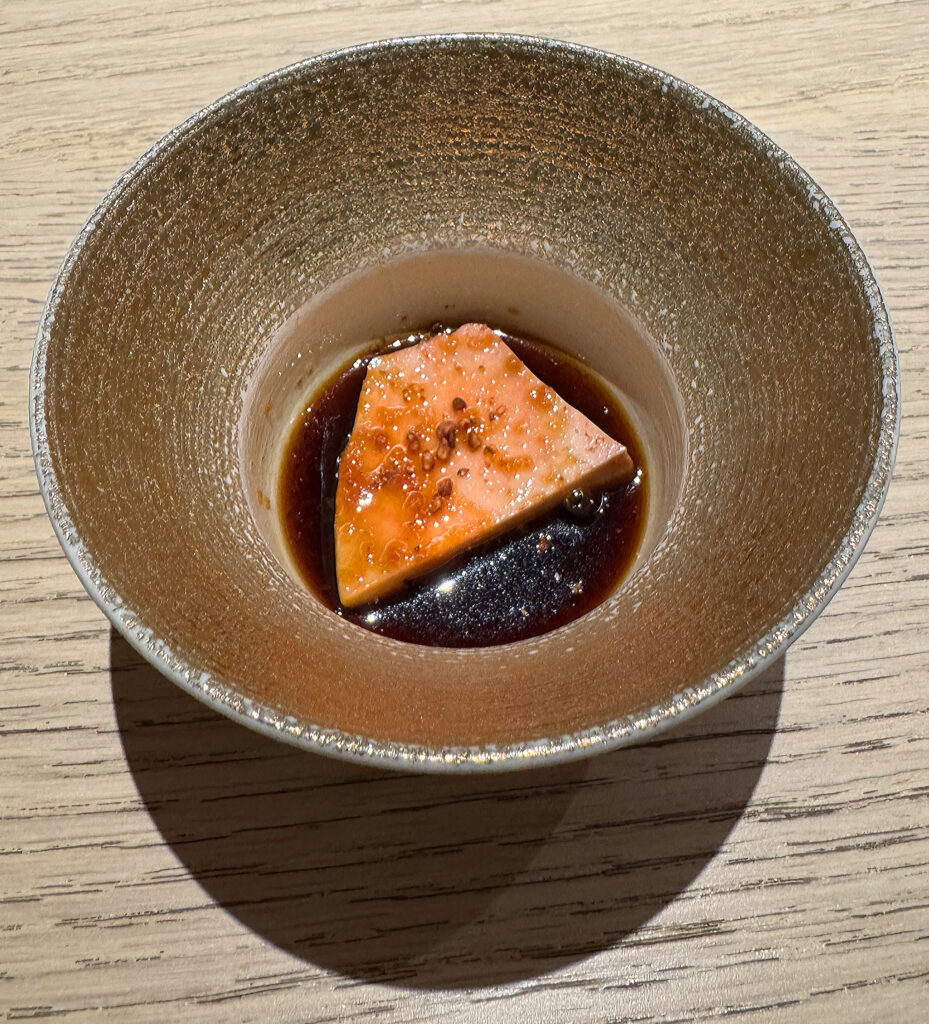
When I catch sight of the “Ankimo” (a preparation of monkfish liver) my mouth begins to water. This recipe, utilizing what the chef titles the “foie gras of the sea,” has not featured since May. However, when in season, it forms one of the restaurant’s signatures: pairing the central ingredient with a potent ginger sauce (bolstered with mirin and sake) as well as a sprinkle of buckwheat.
Texturally, the ankimo displays a degree of refinement that is sure to please any guest who feels wary upon hearing that word “liver.” The portion here is generous, yes, but also impeccably smooth. The topping touch of brittleness helps to contrast and delineate all the mouthcoating richness, but, in truth, I think this element could be rendered more crisply. Still, the electrifying spice, sweetness, and latent umami of the accompanying sauce remains one of Phan’s finest creations. It charges the monkfish liver with a startling intensity of flavor, only for the fattiness to counter it in equal measure. The result feels lip-smacking and incredibly long—like the best forkful of a traditional foie gras presentation shrank down to bite-size.
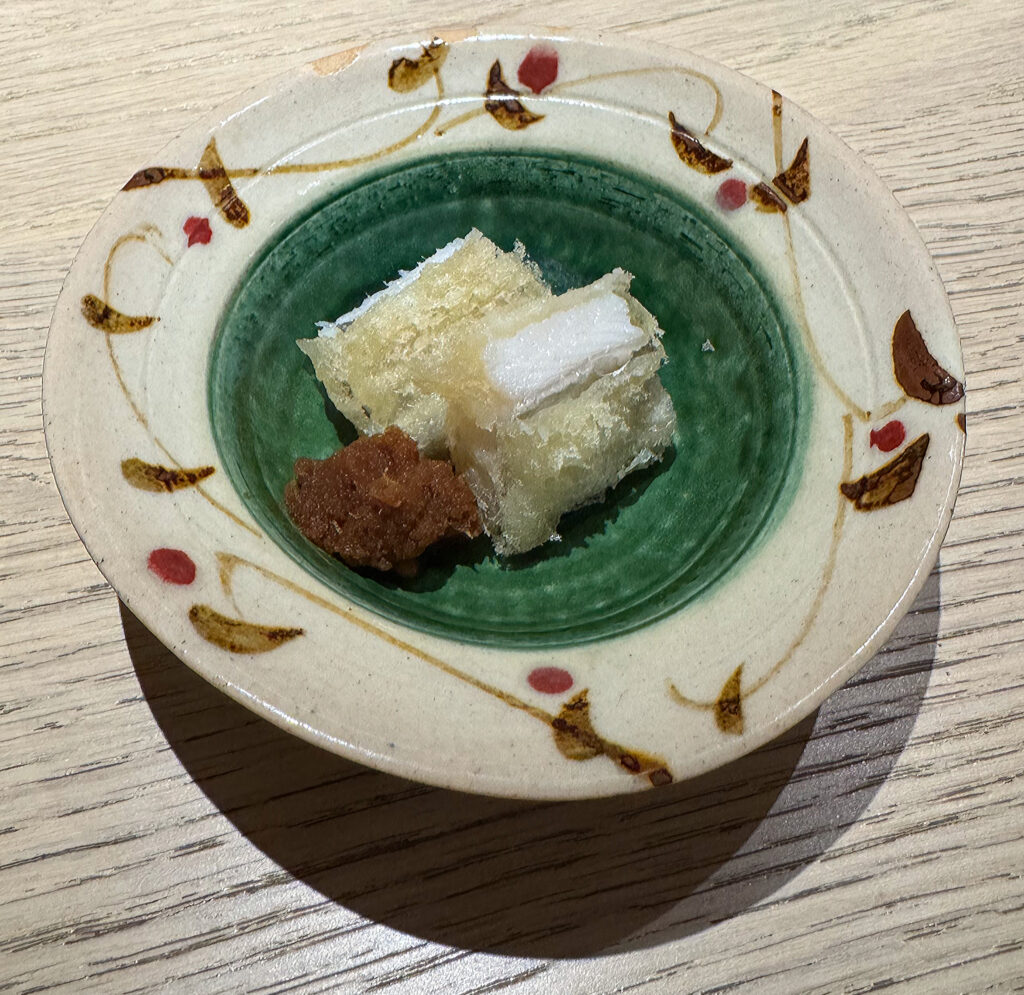
“Tachiuo” (or beltfish) is described by the chef as his “favorite” ingredient for use in tempura. And, if one observes the whisking of batter (made using vodka) and the heating of oil going on behind the counter, it may become clear that diners are in for a fried treat. Indeed, while this technique isn’t executed with the same visual flair one finds with the sushi (or at restaurants dedicated to the tempura form), its introduction to the meal has added welcome depth to the offerings. Phan has also gotten quite good in his execution too.
The beltfish—rendered as two generous pieces—arrives at the center of a shallow bowl where it is paired with a dollop of grated daikon soaked in ponzu. On the palate, the tempura displays a delicate, finely-knit crunch that envelops the ingredient like a shell and forms some flaky, crispy points along the edges. The fish, in turn, is buttery and almost fluffy in its consistency, melting in a way that ensures the fried layer (which is really rather thin) loses none of its impact. Most of the flavor comes by way of the ponzu, and, while I’ve found that the daikon condiment can be strangely muted on some occasions, it does not miss tonight. The sauce’s gentle tang and sweetness cushions (without obscuring) the mild beltfish, crowning its buttery mouthfeel (and the textural thrill of the tempura itself) with a note of lasting satisfaction.
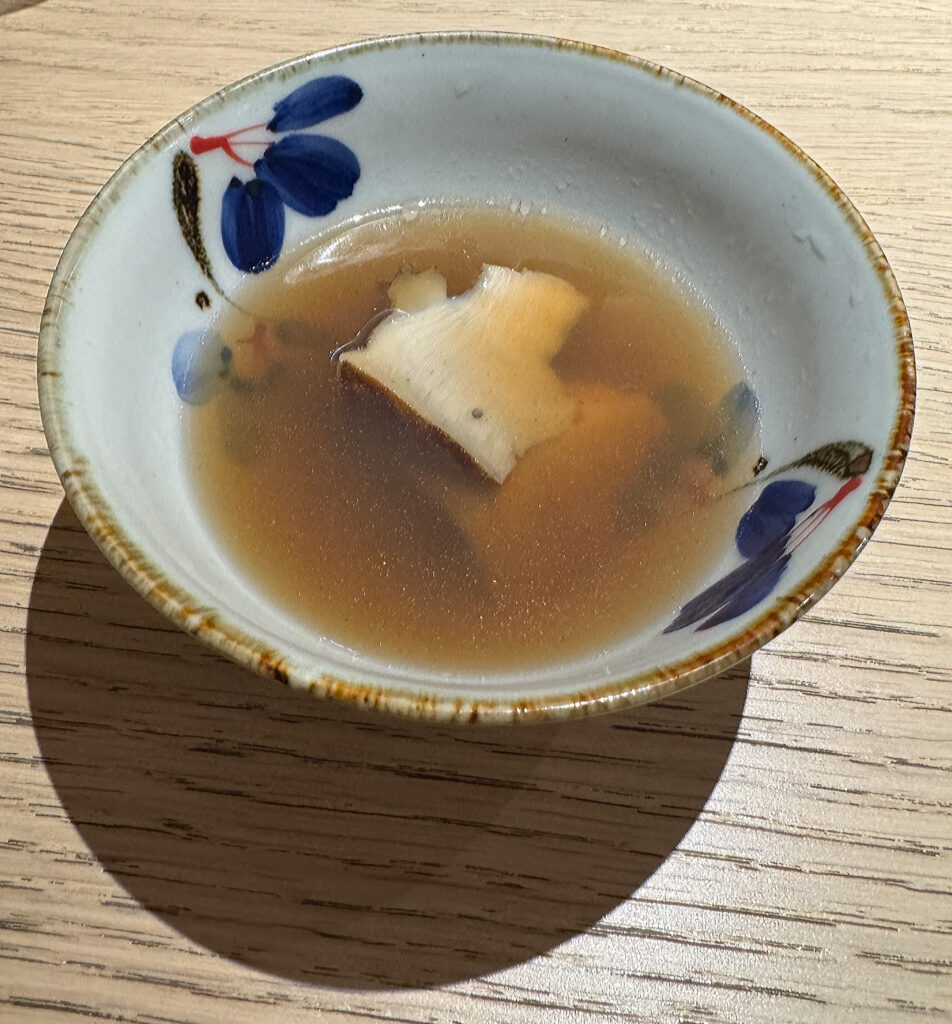
Closing out the menu’s small plates is something entirely new—and rather rarefied. “Black Abalone” (an ear-shaped sea snail) might rank as the most prized of all mollusks. It’s not technically a bivalve, but it eats the same way: each shell yielding a firm portion of muscle (called a “foot”) that is reminiscent of clam meat yet denser, richer, and correspondingly associated with longevity. Frankly, this can be a challenging ingredient for some. However, it also provides one of the clearest windows into what Japanese diners themselves enjoy.
Phan prepares his abalone by gently warming it in an accompanying “abalone broth” that has been fortified with pieces of dried cephalopod (which he proudly showcases to the assembled diners). This is an unexpected part of the recipe to champion. Just the same, it’s hard to argue with the results. The liquid feels soothing in the mouth, gripping the tongue with its umami but unwinding to display harmonizing notes of sweetness and brine. The abalone, in turn, is plump and chewy on entry but softens with further chewing. It’s a strange mouthfeel—yet totally captivating and singular once one develops a taste for it. Moreover, the mollusk is remarkably clean and homogenous in its consistency, leaving behind an impression of sweet and salty flavor (echoing the broth while further enhancing its length) that is simply sublime. Overall, this makes for one of Kyōten’s most intriguing dishes in quite some time, and one that, all the better, is matched by unerring execution.
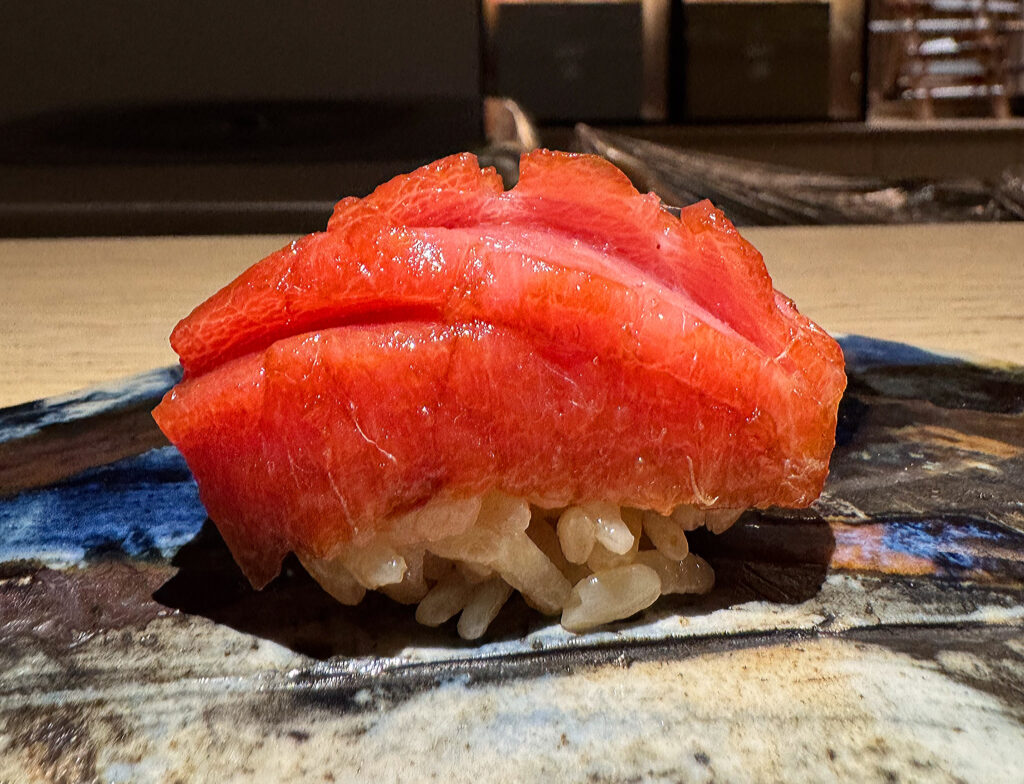
Tonight’s nigiri sequence begins, as it often does, with “Chū-toro.” This medium-fatty cut of tuna does not always command the same attention as its fattier peer ōtoro. However, in Phan’s hands, the piece has proven capable of balancing texture and flavor in a way that topples traditional hierarchies.
Visually, the fish’s flesh ranges from red to pink in tone and boasts a fine web of marbling running across its surface. Some uneven scoring (both horizontal and vertical) forms discernible ridges that help to shape the slice around the rice. On the palate, the chū-toro strikes with a consistency—so seamless, so buttery—seemingly free of any structure. The tuna melts with maddening speed only to be countered by a bracing burst of fresh wasabi that steers the bite’s flavor toward a wonderful sweetness (on the midpalate) and deep, soy-kissed umami on the finish. In short, this is about as good as sushi gets, and I am starting to think there might really be something to the chef’s appraisal of his ingredient quality this season.
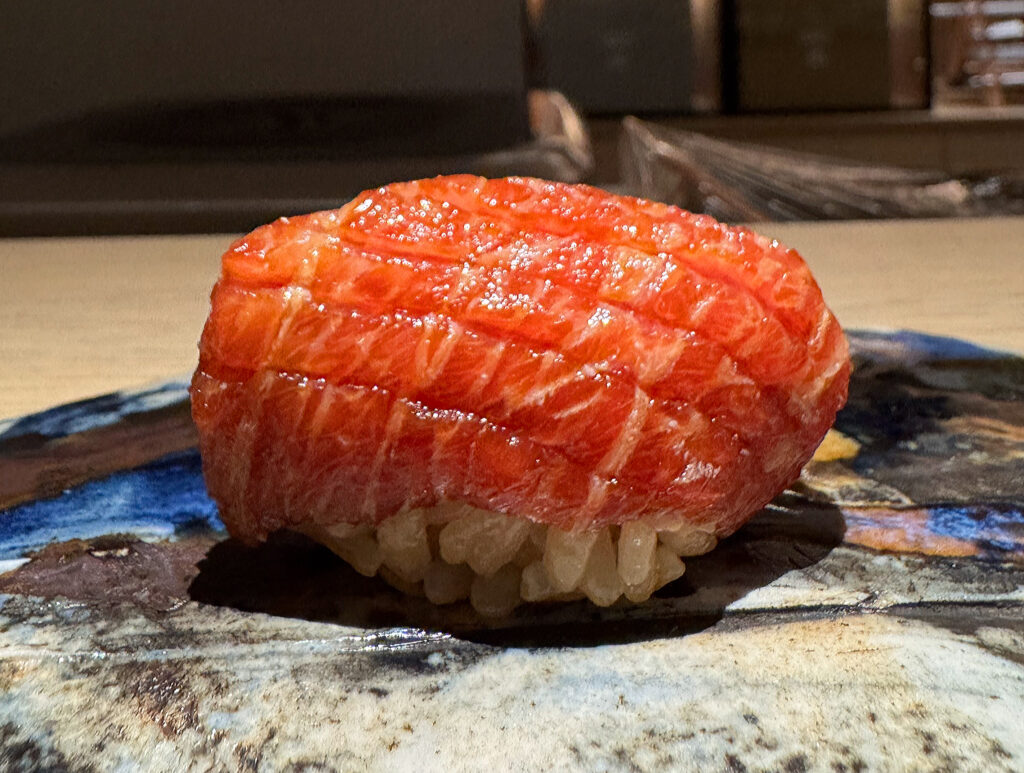
Arriving next, the “Kama-toro” (a cut taken from the collar of the same fish just served) is something of a rarity. I recall the piece having been served at Kyōten before—but never more than once or twice in a given year. It certainly hasn’t featured in 2025 (though “Buri Kama” has), and I am left believing that conditions must really be remarkable if they have delivered such a precious offering so promptly.
Visually, this section of the tuna is characterized by a paler tone of red with all of the same webbed marbling and, uniquely, some thicker veins of fat. Parallel horizontal scoring helps to delineate the flesh, creating a ribboned effect. Texturally, the collar diverges from the chū-toro in its embrace of structure. Indeed, though so streaked with white, the piece displays real staying power: almost something of a chew, almost what you might call sinewy. Nonetheless, it goes down easily, delivering a fairly straightlaced flavor that is marked less by wasabi (or corresponding sweetness) and more by a pure, savory character. Ultimately, I think the “Ōtoro” (which this bite served to replace) tends to be stronger. However, there’s no question that this cut of collar is great, maybe even more singular, and a dream pairing with the medium-bodied red wines Phan sometimes likes to serve.
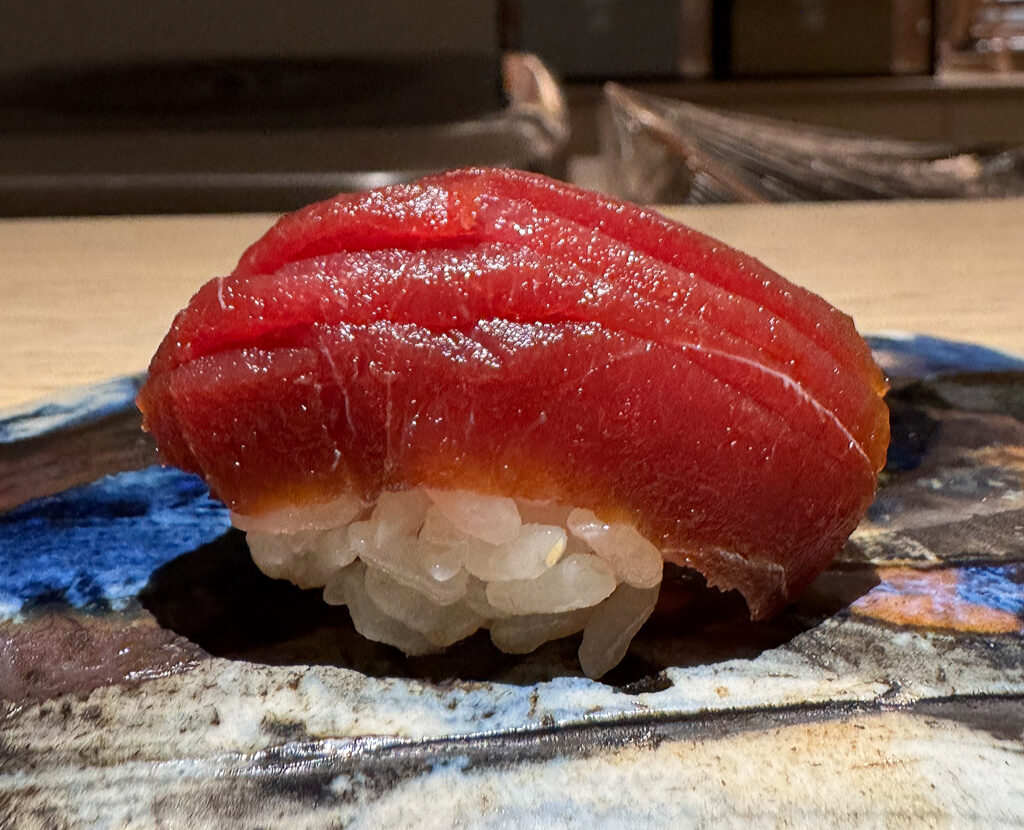
“Akami” (or lean tuna) typically closes the sequence, veering away from expressions of fat toward a counterbalancing embrace of the ingredient’s carnal appeal. Visually, the piece possesses the darkest red color of the bunch with almost none of the same interlacing marbling. However, benefitting only from some light horizontal scoring, the cut displays a plumpness and softness that, for me, proves a little more appealing than the kama-toro (which, in reflection, might have been held back by those thicker white veins). The accompanying flavor here—combining a firm imprint of soy sauce, a tinge of sweetness, and some complicating irony notes—is more attractive for my palate too. Yes, while the akami falls just shy of the chū-toro’s quality, it represents a tremendous effort: one that edges out the prized collar to affirm exactly what the tuna’s leaner meat has to offer.
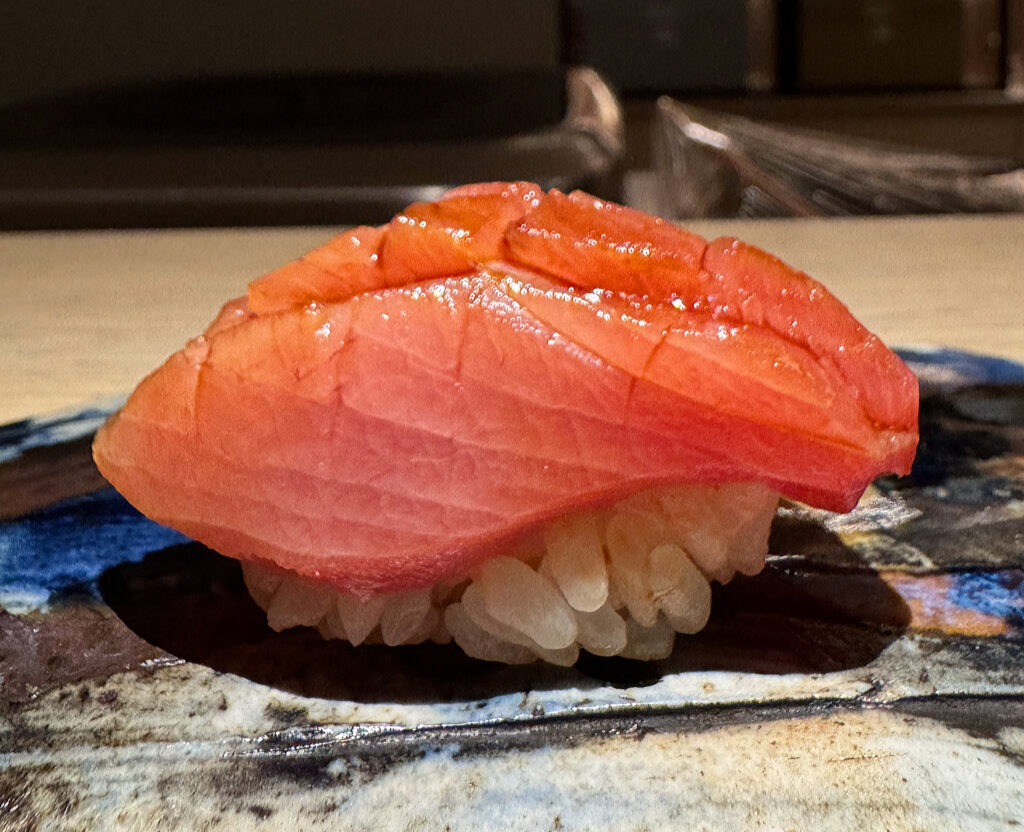
The ”Buri” (a kind of wild mature yellowtail) that comes next is one of Phan’s signature offerings. That said, it almost always has the unenviable task of appearing after what, for many, are the meal’s unquestionable headliners. The fish, in this role, often does a good job. Tonight, however, it excels: landing somewhere around the same level of quality as the kama-toro and akami.
Visually, the yellowtail is characterized by a pale pink tone and seemingly fluffy, almost padded flesh. The piece is scored horizontally (once down the middle) and vertically (four times at equal intervals), creating a pocket that helps to pool an accompanying brush of soy sauce. On the palate, the buri feels soft on entry but, with further chewing, gushes with succulent fat. While the topping provides an expected imprint of umami, it also reveals a latent sweetness in the fish: one that strikes pristinely, with a building intensity, all the way through to the bite’s finish. The sum effect is startling—has the ingredient always promised this kind of lip-smacking flavor? For whatever reason, it proves totally convincing on this occasion.
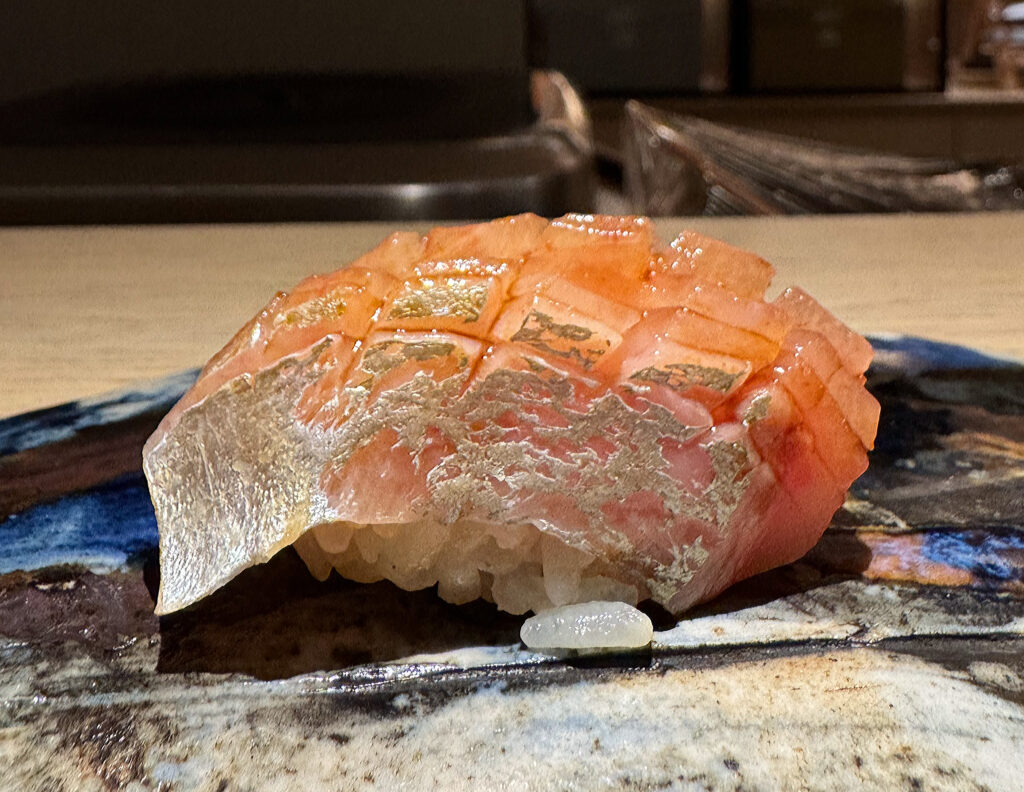
I have not seen “Shima Aji” (or striped jack) appear on the menu at Kyōten in quite some time. Regrettably so, for it has formed a favorite piece since my earliest days of omakase appreciation. On the back of four superlative bites, the fish seems destined to fall short, and, this time, I must admit that it cannot keep up with the tuna or yellowtail. But it comes damn close: delivering a pleasing firmness on entry that breaks apart into unctuous chunks, striking with pronounced notes of pungent wasabi and some enchanting, contrasting sweetness. Overall, this misses some of the same elegance as those headlining pieces. Nonetheless, it delivers a kindred kind of satisfaction that stands among the best things Phan has served during this opening section of the sequence.
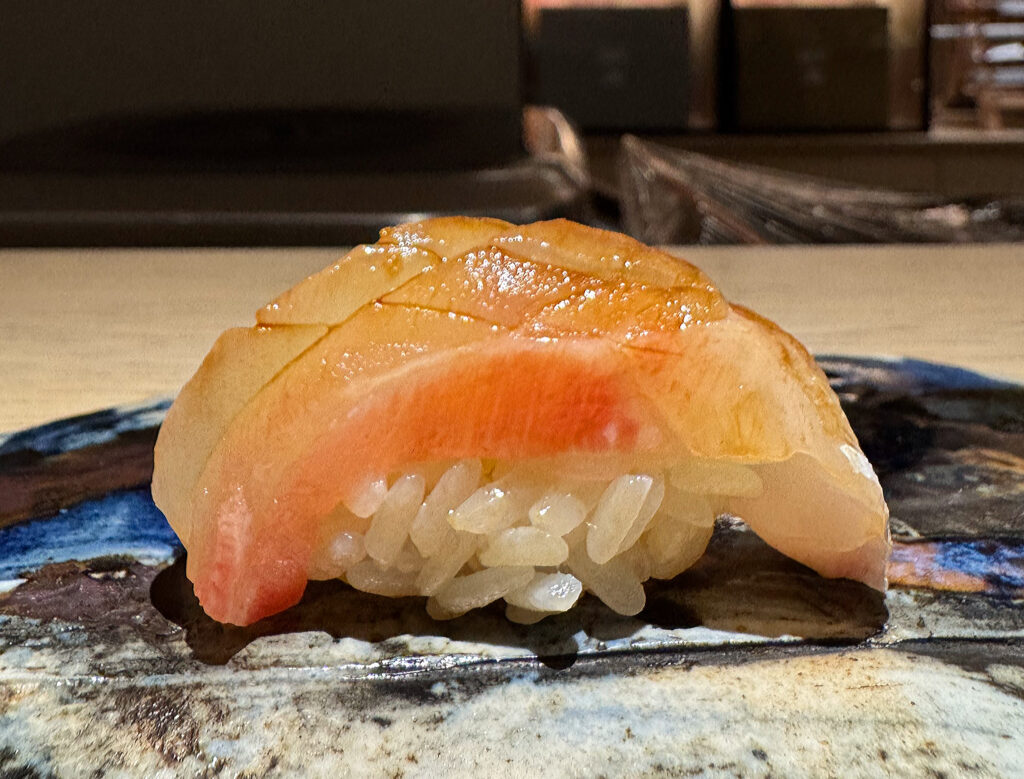
Of course, not every mouthful of nigiri served here is a star. Some act as workhorses: a kind of interlude that, while unique and maybe even essential to the flow of the menu, is not really competing to be among the most delicious of items. The “Madai” (alternatingly called red sea bream or red snapper) plays that role tonight. As is often the case, the chef pairs the fish with a bit of lemon zest. This yields a piece of pleasing firmness (and eventual give) backed by tart, pithy notes that tend too much toward burning bitterness at times to really be enjoyable. If matched by a heavier dose of soy sauce, the madai might easily be capable of yielding more satisfaction. However, I’ve accepted that this fish really acts as a vehicle for the citrus, and it seems fair to judge it, in part, as a palate cleanser for what comes next.
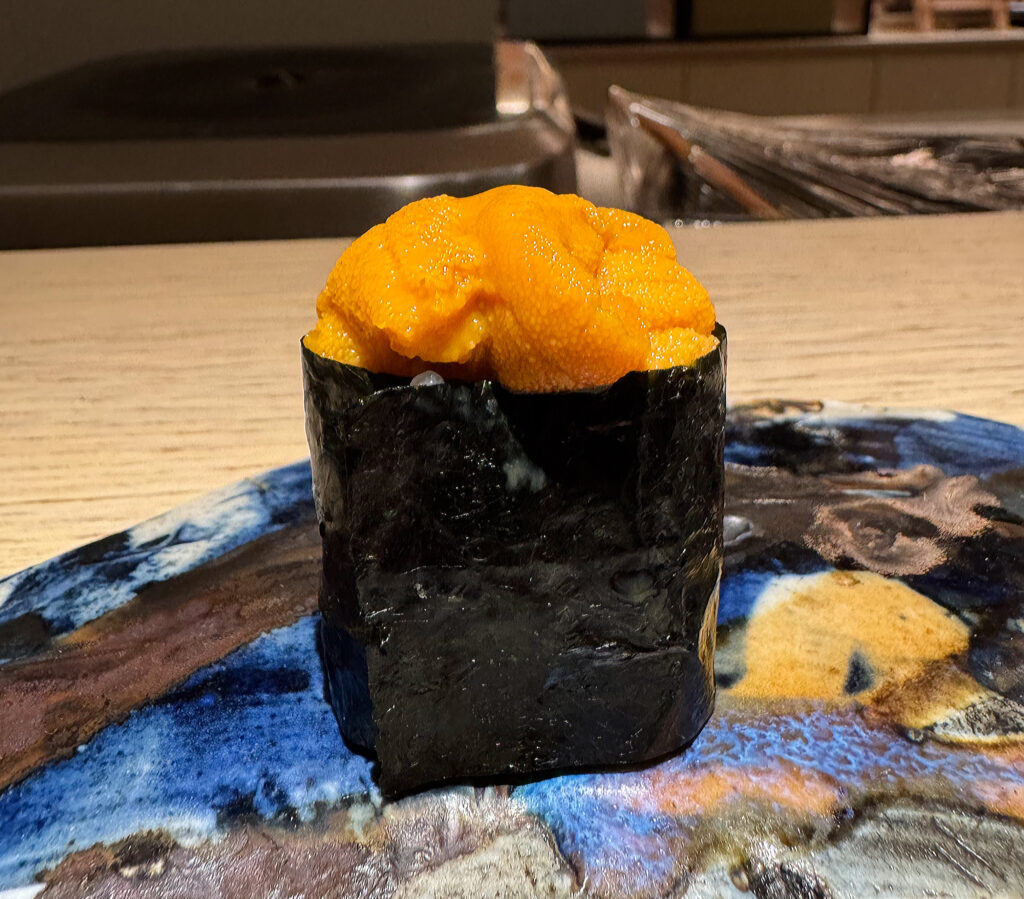
When “Uni” (or sea urchin) is revealed to be next on deck, I begin to feel like that lemon refresher was perfectly timed: laying the groundwork for a heightened appreciation of these coveted gonads. Phan continues to source the ensui (or preservative-free) variety of this ingredient. However, while the last few examples have been “dry-packed” (what he describes as the ideal), the present serving comes soaked in saltwater solution (a format the chef still views as superior to the usual trays).
The resulting piece comprises a few oozing, dimpled lobes layered atop a ball of rice wrapped in nori. The melty orange mound also arrives free of the soy sauce drizzle that sometimes features as a finishing touch. On the palate, the uni is expectedly creamy, but the seaweed—vexingly (as I cannot remember this ever being the case)—is limp. This robs the bite of its essential textural contrast, leaving behind a flavor that is mildly sweet and mildly irony but, ultimately, only a shadow of the kind of cohesive, convincing decadence sea urchin so routinely delivers here.
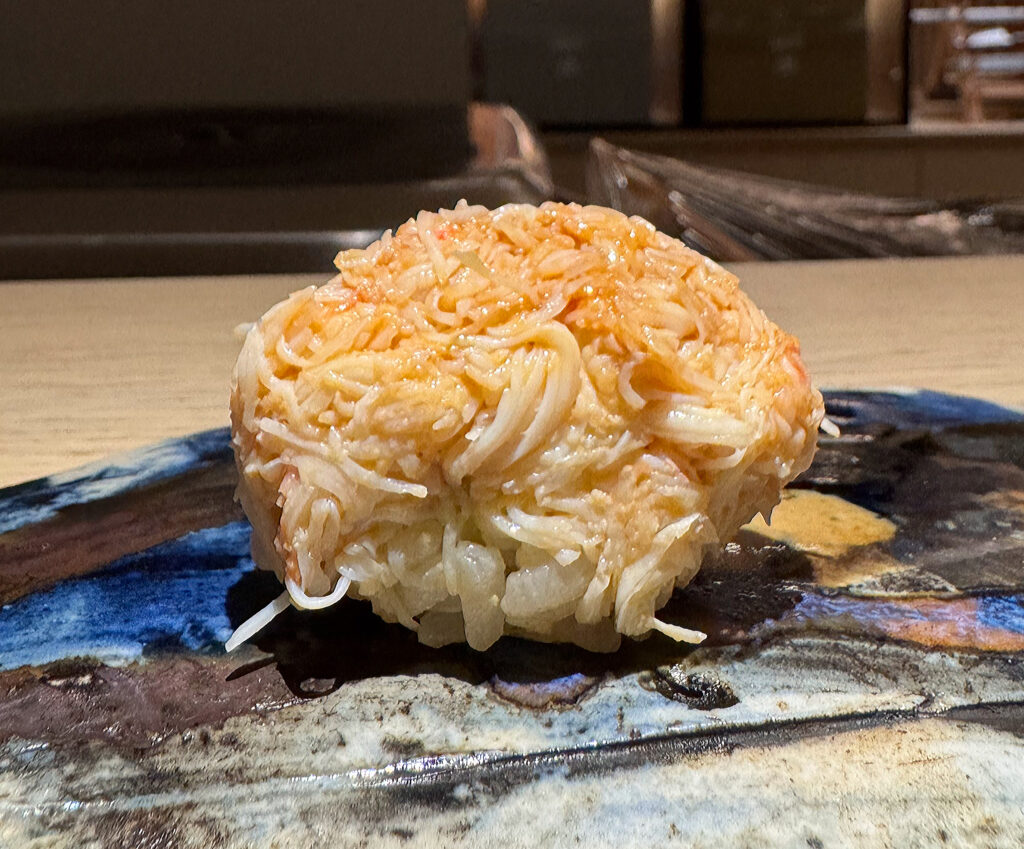
A preparation of “Kegani” (the very same horsehair crab, sourced from Hokkaido, that Phan was cracking upon guest arrival) looks to turn things around. After all, I’ve so rarely seen this ingredient feature here, and it’s never taken the form of nigiri before.
Visually, the bite is made up of many fine threads of the crustacean’s flesh that have been knit together into something resembling a spool of noodles. Finished with a drizzle of soy sauce, the crab feels firm on the palate: emphasizing the piece’s innumerable layers but not exactly providing the same melty, buttery mouthfeel provided by other species. Indeed, the texture here is true to type. However, the resulting flavor—which leads with iron and fails to match it with any sweet or savory backing—falls short. Overall, I think the kegani has all the makings of a memorable item. Yet, at present, its effect is haunting rather than enjoyable. Whether this was due to a problem with the quality of one particular crab or, in turn, some shortcoming of the chosen seasoning, we will have to see.
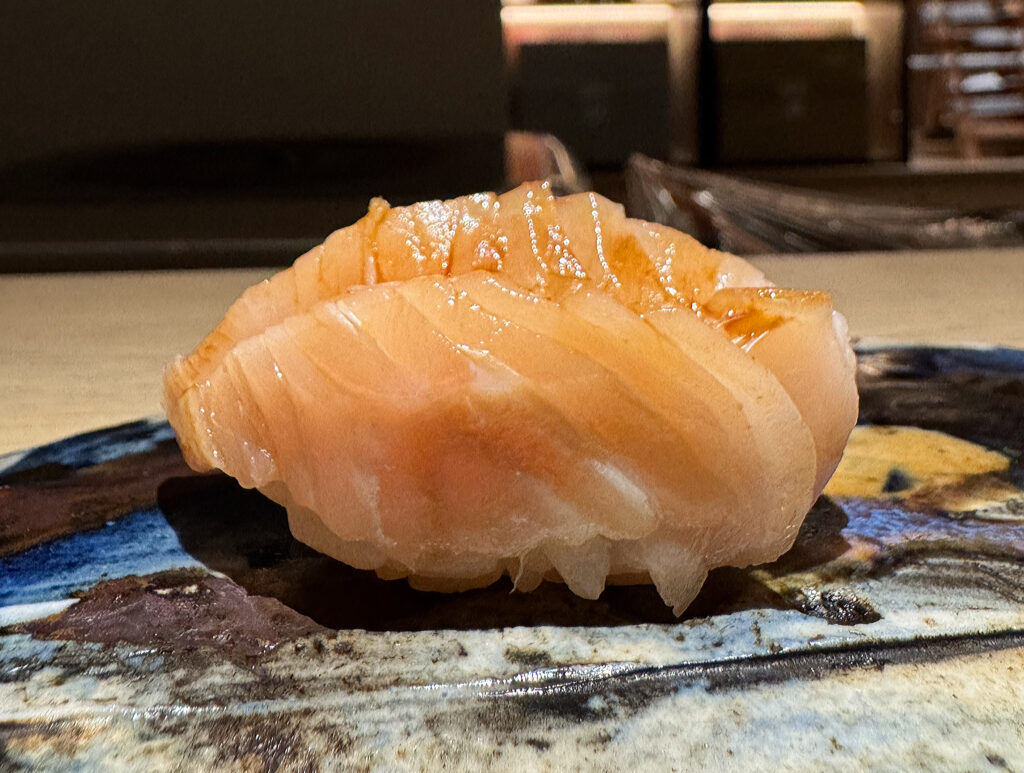
The “Sawara” (or Spanish mackerel) hardly pleased me back in September, yet Phan describes the specimen he prepares tonight as “super, super fatty”—that is, about as fatty as he “ever sees.” Serving a belly cut only adds to the effect, which, after a few disappointing pieces, works to bring the omakase back on track.
Visually, the sawara is characterized by ribbons of milky flesh (the product of vertical scoring) set against a single slice made (horizontally) down the middle. The latter helps to nestle a brush of soy sauce: one that provides just enough savory backing to help the mackerel’s clean, mild, subtly sweet flavor shine. Otherwise, the bite impresses with its gently chewy, then creamy mouthfeel—a combination of delicacy and perceived richness that helps the fish shine in a manner I have never, up until this point, encountered.
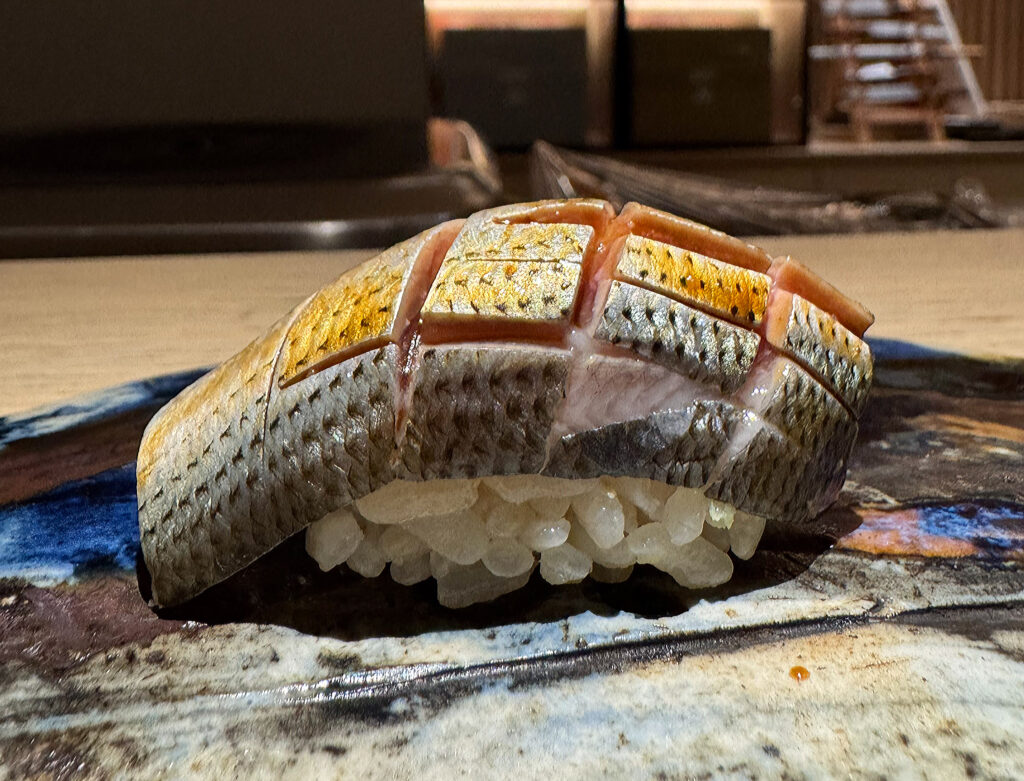
“Kohada” (also known as gizzard shad) has not appeared as part of the omakase since back in March. It’s not only one of Phan’s signatures, but a piece (he describes) that the skill of any sushi chef is traditionally judged on—so involved is the process of deboning, curing, and marinating the fish. The present example is championed as the “greatest” ever served at the restaurant, and I have to agree.
Visually, the kohada displays its hallmark shiny silver skin and a pale, reddish interior flesh (made visible through crosshatched scoring). When it reaches the palate, the gizzard shad leads with some semblance of structure. However, the fat quickly takes over: cushioning the firmer, somewhat oily outer layer and making for a bite that feels rich and homogenous with further mastication. The resulting flavor here is rooted in the tang of the vinegar used for the marination. Yet this note, in turn, is matched by a punch of wasabi and a well-judged dab of soy sauce that drives the fish’s flavor toward a beautiful sweet-savory balance. Overall, this makes for an expert rendition of the prized (and, for many diners, obscure) ingredient. It not only represents a rousing return to the menu but also ranks as one of the meal’s highlights.
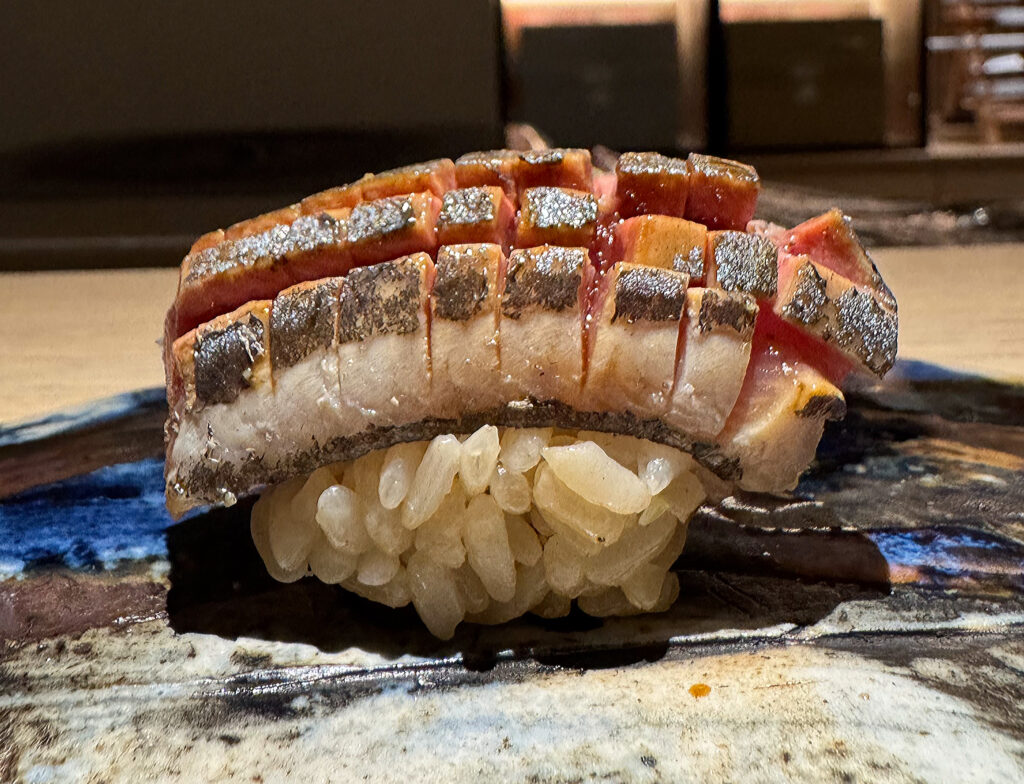
The “Sanma” (or pike mackerel) that arrives next was a surprise hit in its own right when I encountered it in September. Phan advises that the ingredient tastes “strong” but “shouldn’t be fishy,” and, indeed, I find it leads with firmness, a unique meatiness, and a mouthcoating oily quality for good measure. The flavor here is characterized by a pronounced saltiness—the kind that helps to cut the richness and funk that lie at the heart of the mackerel. The sum effect, thus, is enjoyably savory while remaining clean enough to be approachable. However, with the reintroduction of the kohada, I think the sanma suffers as a less elegant, less satisfying example of the same kind of bite.
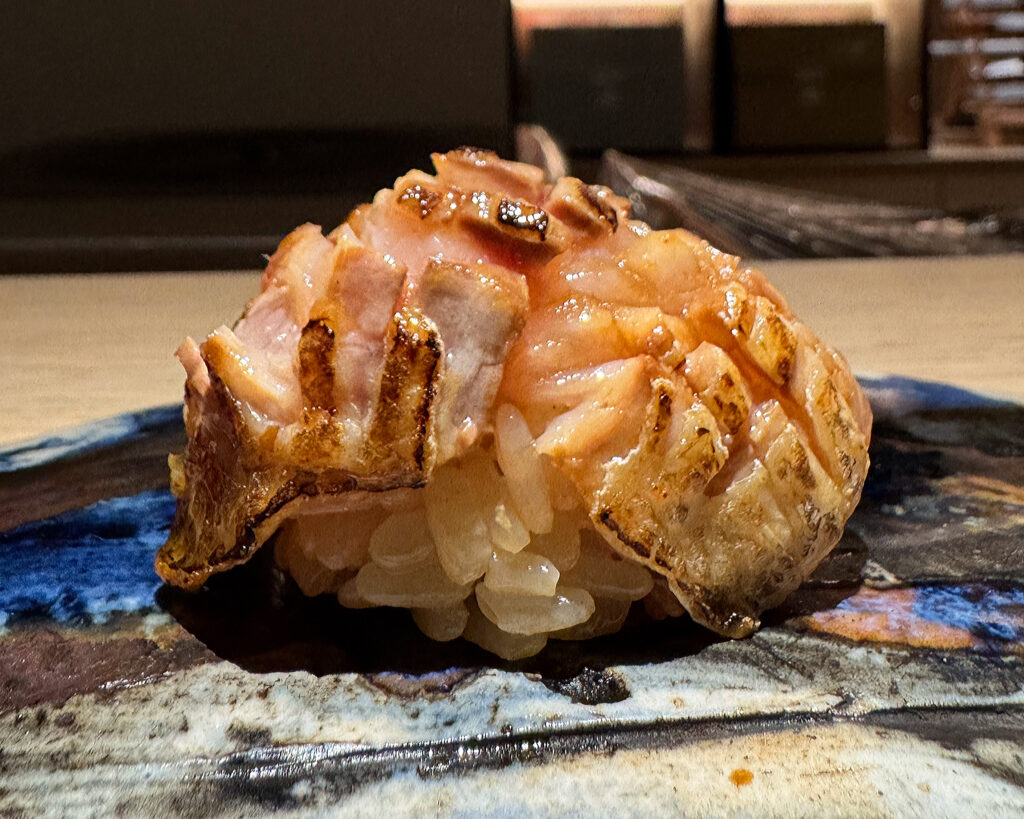
Closing out the nigiri sequence is a bite of “Akamutsu”—that most luxurious blackthroat seaperch that has featured on every menu since May. The chef describes the fish as something “like a snapper” but also “crazy fatty like fatty tuna.” With the benefit of some light torching, the piece displays a weighty, melty consistency with just enough sharpness (drawn from a pinpoint application of wasabi) to counter all the richness. I even sense a bit of sweetness on the finish, distinguishing this rendition of the akamutsu as one of the omakase’s most successful, textbook examples.
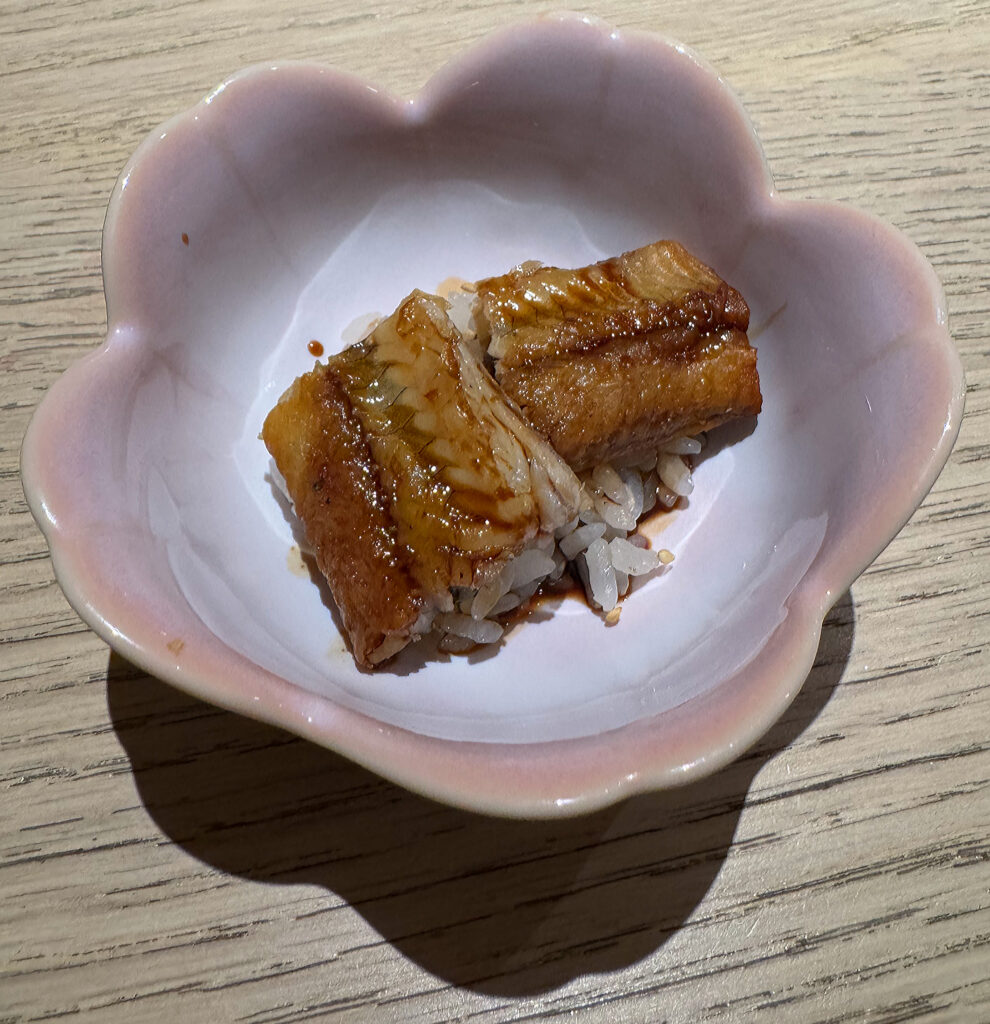
The last of the savory preparations tonight centers on “Unagi” (the grilled wild freshwater eel Phan terms “the most special thing I serve”). Two sizable fillets of the fish are glazed with a sweet sauce (that calls the archetypal, sticky condiment to mind while refining it) and served atop a mound of rice that is dressed in the same fashion.
On the palate, the eel combines a charred, brittle exterior with fluffy, tender flesh. There’s something soothing and substantial about the resulting mouthfuls, making unagi one of the omakase’s most reliable anchors. The sweetness of the sauce, which serves to draw out the same note in the fish, only heightens the effect. However, past examples of the recipe have shown even greater intensity (of shattering crispness and flavor alike), so I must label this iteration as falling a little short of its full potential.
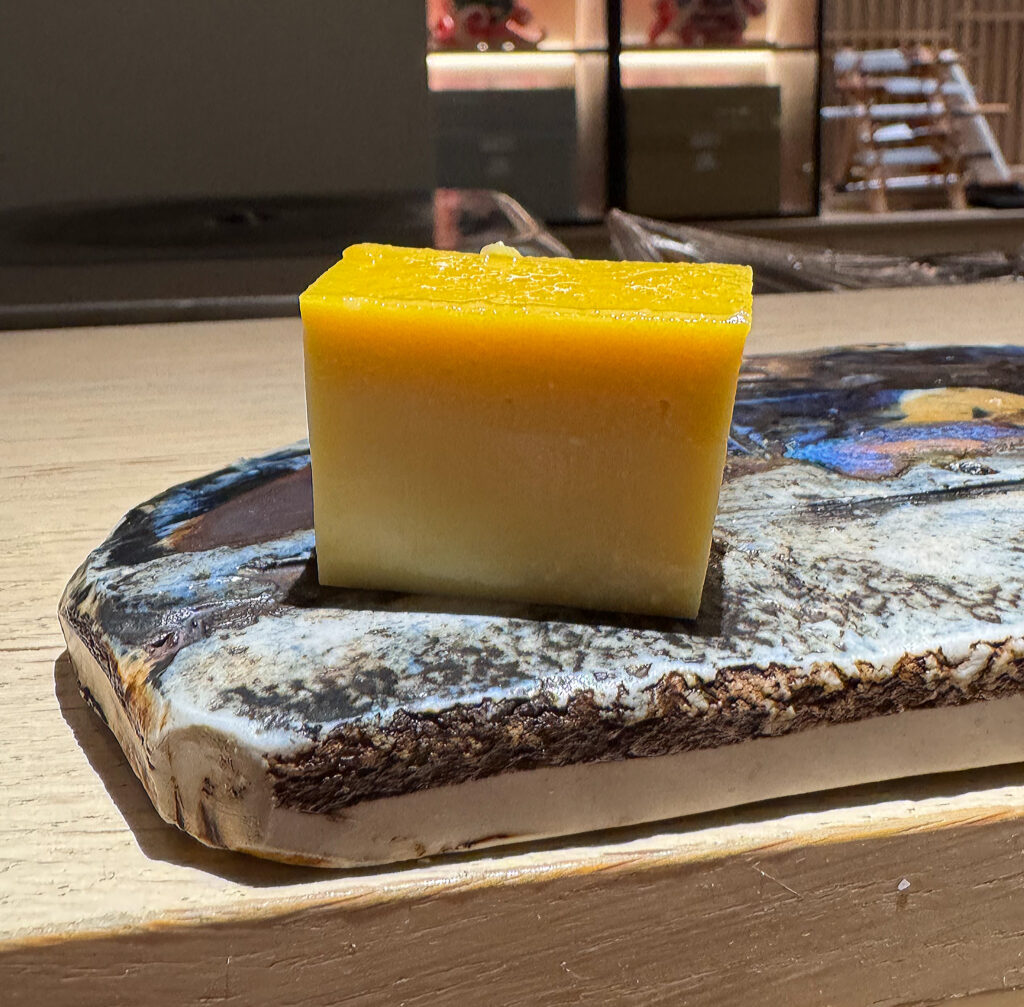
Kyōten’s classic “Tamago” (rendered here as a corn- and maple-infused custard) takes its customary place at the start of dessert. Tonight, I encounter none of the flaws (typically related to serving temperature) that can shortchange what should be a winning bite. Instead, the tamago strikes with an effusive, eggy mouthfeel and a concentration of toasty, caramelized flavor (a touch darker than I’m used to) that displays considerable length. In short, this rendition more than lives up to the item’s signature status at the restaurant.
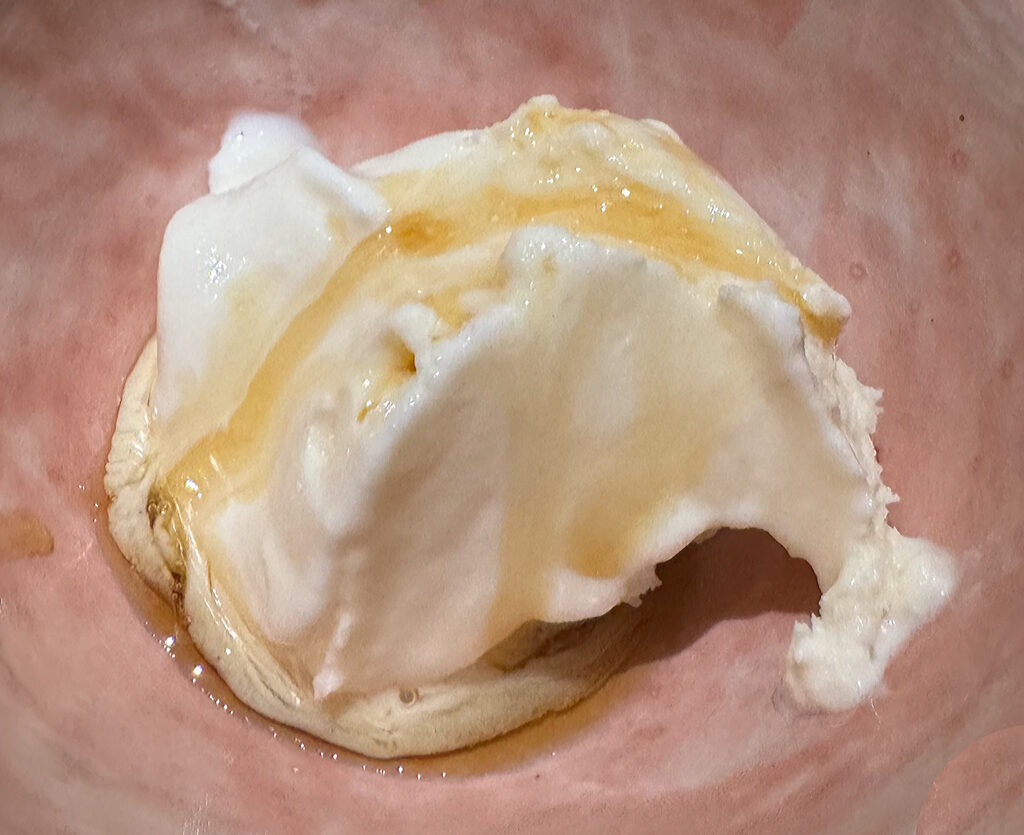
The evening’s final dish expands on Phan’s longstanding work with frozen desserts. While the chef has favored dairy-free sorbets from time to time, his “White Cheddar Ice Cream”—topped with a drizzle of maple syrup—aims wholly at decadence. It offers a smooth, rich consistency with layers of salty, tangy, and nutty flavor that are supercharged by caramelized sweetness. Yes, one can actually taste the cheddar on the finish, but there’s so much else going on—so much depth and length to the composition—that one can only nod their head in admiration. This might be Kyōten’s most creative and satisfying work in the format to date.
On that note of indulgence, the evening draws to a close. Phan expresses his gratitude to the assembled diners, instructs them that their deposits will be refunded (meant to help facilitate the splitting of checks), invites them to book future reservations through him directly, and then retires to the foyer: where, over a glass of wine, the chef makes himself available for any kind of conversation the departing guests want to have.
The bill arrives but a moment later, reflecting nothing more than the base price, any additional beverage, and tax. Otherwise, there’s no pressure to leave (if one wants to finish their drinks or continue chatting away with their party). But, a tight three hours later, it feels liberating to walk out that disguised door: well-fed (but not stuffed), spellbound by concentrated flavor (but none of it cloying), texturally thrilled (but not grossed out), and now intimately aware of what goes on inside (but not squeezed to such a degree that coming back seems out of reach).
In ranking the evening’s dishes:
I would place the “Chū-toro” in that “legendary, lifetime status” of tuna I encountered (with the “Ōtoro”) back in February, July, and September. Now that there have been so many examples at this level of quality, I must begin to question just how accurate that “once-in-a-lifetime” descriptor really is. However, the bite remains worthy of being placed in its own highest stratum: something close to the pinnacle of what the sushi form is capable of achieving. I dream of encountering pieces like this again.
The “Ankimo,” “Kama-toro,” “Akami,” ”Buri,” “Shima Aji,” “Kohada,” and “White Cheddar Ice Cream” land in the next category: superlative items that stand among the best things I will be served in any restaurant this year.
Next come the “Aka Ebi,” “Tachiuo,” “Black Abalone,” “Sawara,” “Akamutsu,” “Unagi,” and “Tamago”— very good—even great—preparations I would always be happy to sample again (but that just failed to elicit an extra degree of emotion).
Finally, there’s the “Madai,” “Uni,” “Kegani,” and “Sanma”—merely good items that fell a bit short when it came to texture, flavor, or serving temperature. None of these bites faltered in more than one dimension, so there was still pleasure to be had (and, undoubtedly, they could all easily be fixed).
This makes for an overall hit-rate of 79%, which seems low at first glance but could really rise to 95% (if one acknowledges that the limp seaweed served with the sea urchin was the only clear flaw) or even 100% (if one accepts that the uni itself was acceptable and the other pieces, if not highlights, each expressed unique texture/flavor combinations that added breadth and depth to the meal).
The real figure worth noting is that some 42% of items landed in the “legendary, lifetime status” or “best of the year” stratums: a simply immense showing that many experienced diners would cherish even if the remaining 58% of dishes fell completely flat.
But that was not the case, and, indeed, top examples of the ”Buri,” “Shima Aji,” and “Kohada” (probably the finest ever served at Kyōten) were followed by preparations like the “Aka Ebi,” “Tachiuo,” “Black Abalone,” and “Unagi” that (on any other night or after a bit more tweaking) could easily land in the “superlative” category too.
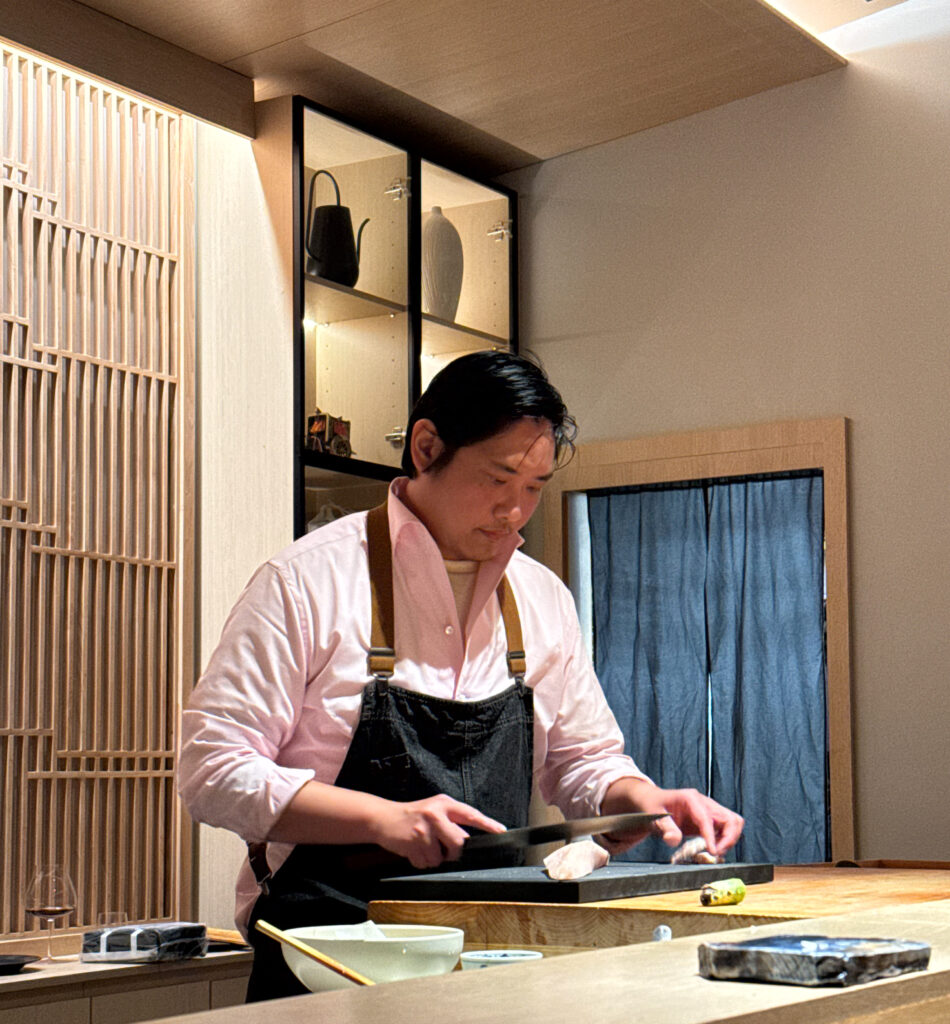
In the final analysis, I cannot deny that this menu ranks alongside—and maybe even surpasses—the strongest that Phan has put out this year. I certainly struggle to think of any Chicago omakase from any year that matches it. With this in mind, it’s hard not to agree that the present cold season has yielded some incredible ingredients. It’s also impossible to deny that the chef, when cooking simply with top-quality products (rather than innovating with the fruits of those weaker warmer months), continues to hit the bullseye with the same (or even more) regularity.
Clearly, there’s no stage fright behind the counter here. There’s no tendency to play things too safe or treat nature’s bounty too preciously just because fish of this character is so rarely seen. Phan, as he has demonstrated through the entirety of 2025, operates with total confidence. In fact, it’s scary to think of what this meal would have been like if the “Uni” and “Kegani” achieved the kind of pleasure they seem so easily capable of.
However, in closing, I really have nothing to complain about. Tonight formed a memorable benchmark—maybe even a bonafide peak—for Kyōten’s work, and I find myself tempted to say: if you’ve ever thought about splurging on dinner here, this might be the moment to finally bite the bullet.
Of course, there’s a difference between one spectacular shipment of fish and a whole season’s worth of goodies. I trust Phan’s judgment, but, moving forward, I’ll have to see if this level of quality is maintained.
All initial signs point to that being the case, and, if the chef is accurate in his prediction, the greatest pleasure may still be yet to come.

